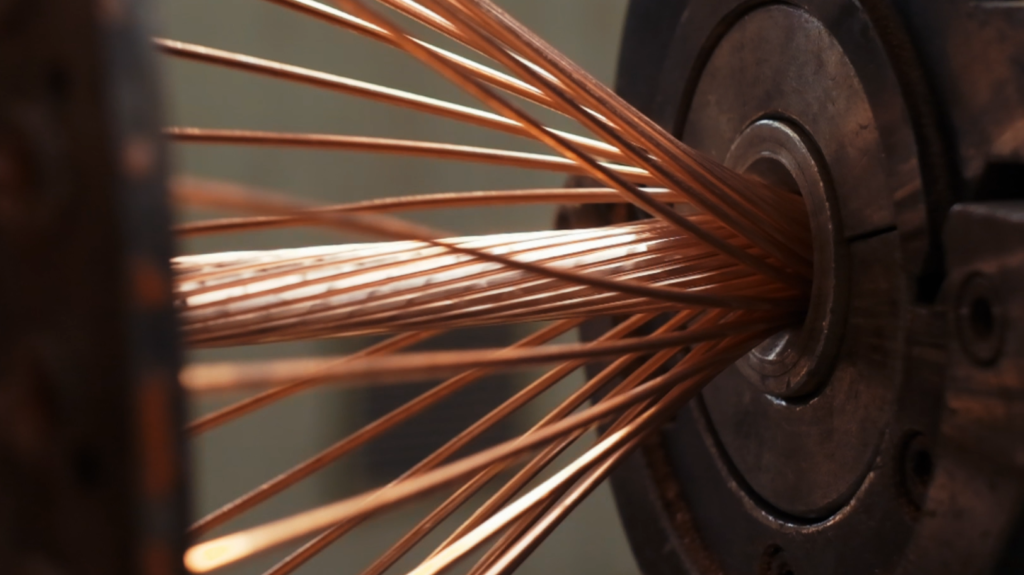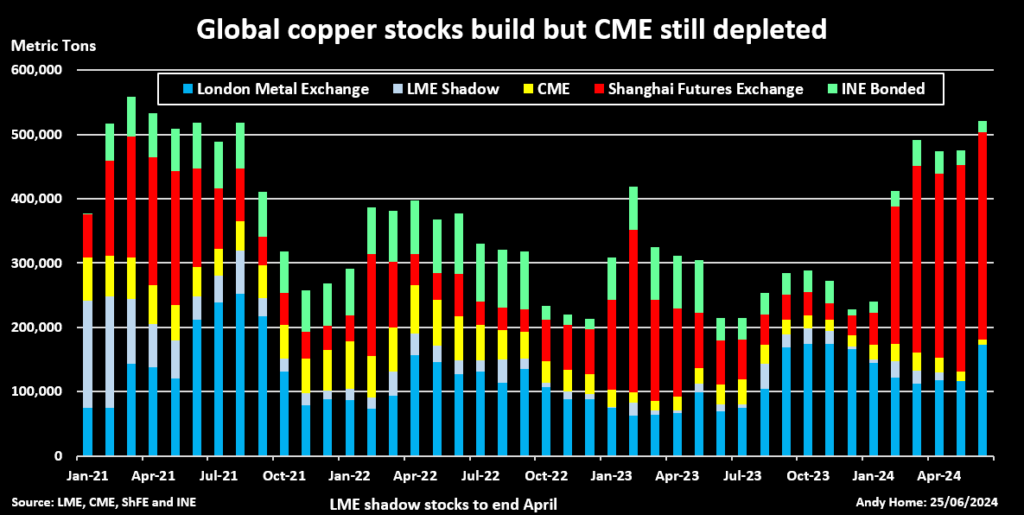
Copper stocks registered with the world’s big three exchanges have risen above 500,000 metric tons for the first time since August 2021.
London Metal Exchange (LME) inventory has surged by 56,850 tons so far this month and at 172,850 tons is the highest it has been since December last year.
At least some of the recent inflow has come from China, where smelters have capitalized on LME copper’s spike to a record nominal high of $11,104.50 per ton in May.
China can afford to ship some units. Shanghai Futures Exchange (ShFE) stocks currently stand at 322,910 tons, down only slightly from a four-year high of almost 337,000 tons earlier in June.
The one exception to this trend remains the CME’s COMEX division, where inventory has shrunk to just 8,274 tons, the lowest since 2008.
CME shorts have little option other than to roll positions forward, prolonging a running squeeze in the US market.

Rising global exchange stocks of copper have damped bullish spirits, which is why the LME three-month price has fallen back below the $10,000-per ton level, last trading around $9,600.
The growing mountain of metal also explains the wide contango structure on both London and Shanghai exchanges. The LME benchmark cash-to-three-months period stretched to a contango of $150 per ton early Tuesday, almost matching last month’s record cash discount of $152.50.
Chinese smelters have made no secret of their plans to deliver up to 100,000 tons of copper to LME warehouses.
Sure enough, exports spiked to 73,829 tons in May, the highest monthly outbound volumes since 2016.
It’s likely no coincidence that the main points of arrival in the LME warehouse system this month have been those closest to mainland China. The Taiwanese port of Kaohsiung has received 29,325 tons and the Korean ports of Gwangyang and Busan have registered inflows of 20,400 and 9,675 tons respectively.
Chinese refined metal imports have been robust this year but stubbornly high visible stocks explain why the country’s producers are happy to sell physical metal into the Western market.
ShFE stocks have conspicuously failed to draw after the lunar new year holidays, breaking a multi-year pattern of rapid early-year build followed by equally rapid depletion over the second quarter.
Bonded warehouse stocks have risen from under 10,000 tons in January to a current 89,700 tons, according to local data provider Shanghai Metal Market.
While cumulative inventory on the LME and ShFE has more than doubled in the first half of the year, very little metal seems to have made its way to the United States.
CME warehouses, all on home soil, have not seen any inflows since May and metal has been steadily trickling out of the system ever since.
LME warehouses in Mobile and New Orleans hold a residual 1,375 tons, all but 725 tons of it awaiting physical load out.
COMEX time-spreads have flared into backwardation again over the last couple of weeks as short-position holders move down the forward curve ahead of the expiration of the June contact.
The squeeze has not been as vicious as that in May but it is a sign there are players who are still short and caught, whether in terms of outright price, spreads or a combination of the two.
The disconnect with the London and Shanghai markets is stark and highly unusual.
Physical arbitrage will close the yawning gap between the United States and the rest of the world.
But it has clearly has not yet happened. It does not help that most of what is stored in the LME system does not qualify as a good-delivery brand on the CME.
Chinese and Russian metal accounted for 72% of on-warrant LME stocks at the end of May. The ratio is likely to have risen further in June given the burst of arrivals at LME ports close to China.
Chinese brands are not deliverable against the CME copper contract. Neither are Russian brands, although it would not make any difference if they were since the Biden administration banned all Russian copper imports in its latest sanctions package.
The CME’s good-delivery list is weighted heavily towards domestic, South American and Japanese brands, limiting availability for anyone wanting to divert copper to the United States.
This has become a waiting game as shorts shuffle down the forward curve with one eye on the horizon for signs of inbound shipments.
Until they arrive, the COMEX market is going to remain a turbulent ride for copper bears.
(The opinions expressed here are those of the author, Andy Home, a columnist for Reuters.)
(Editing by Jason Neely)
Comments